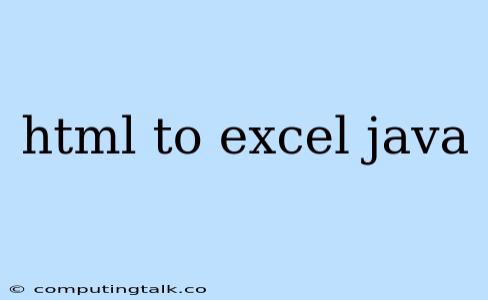Converting data from HTML to Excel format is a common requirement for many applications, particularly those that need to present or analyze data in a structured and readily accessible format. While there are several ways to achieve this, Java offers a robust and versatile approach through its various libraries and frameworks. This article will guide you through the process of converting HTML to Excel in Java, exploring different methods and considerations for implementing this conversion.
Understanding the Process
At its core, converting HTML to Excel involves extracting data from an HTML document and then formatting it according to the structure and styling of an Excel spreadsheet. This process can be broken down into three main steps:
- Parsing the HTML: This step involves reading the HTML content and interpreting its structure, identifying elements like tables, rows, columns, and individual data values.
- Data Extraction: Once the HTML is parsed, the relevant data is extracted from the identified elements. This data could include text, numbers, or even images, depending on the requirements of the conversion.
- Excel Generation: The extracted data is then organized into a format suitable for an Excel spreadsheet, which involves creating the workbook, sheets, rows, columns, and cell formatting.
Choosing the Right Java Library
Java offers a range of libraries that simplify the process of HTML to Excel conversion. These libraries often provide a combination of features for parsing HTML, manipulating data, and generating Excel files. Some popular libraries include:
- Apache POI: A widely used library for handling Microsoft Office file formats, including Excel (
.xlsand.xlsx). It provides robust APIs for creating, manipulating, and reading Excel documents. - JExcelApi: Another library specializing in Excel file manipulation, providing a more lightweight option compared to POI.
- jsoup: A popular Java library for parsing HTML documents. While not directly focused on Excel generation, it can be used in conjunction with libraries like POI for data extraction and manipulation.
Example Implementation with Apache POI
Here's a simple example demonstrating how to convert an HTML table to an Excel spreadsheet using Apache POI:
import org.apache.poi.ss.usermodel.*;
import org.jsoup.Jsoup;
import org.jsoup.nodes.Document;
import org.jsoup.nodes.Element;
import org.jsoup.select.Elements;
import java.io.File;
import java.io.FileOutputStream;
import java.io.IOException;
public class HtmlToExcelConverter {
public static void main(String[] args) throws IOException {
// Path to the HTML file
String htmlFilePath = "path/to/html/file.html";
// Create a new Excel workbook
Workbook workbook = WorkbookFactory.create(true);
Sheet sheet = workbook.createSheet("HTML Table");
// Parse the HTML using jsoup
Document doc = Jsoup.parse(new File(htmlFilePath), "UTF-8");
// Find the table element in the HTML
Element table = doc.selectFirst("table");
// Iterate through the table rows
Elements rows = table.select("tr");
int rowIndex = 0;
for (Element row : rows) {
Row excelRow = sheet.createRow(rowIndex++);
// Iterate through cells in the row
Elements cells = row.select("td");
int cellIndex = 0;
for (Element cell : cells) {
Cell excelCell = excelRow.createCell(cellIndex++);
excelCell.setCellValue(cell.text());
}
}
// Save the Excel workbook to a file
FileOutputStream fileOut = new FileOutputStream("converted.xlsx");
workbook.write(fileOut);
fileOut.close();
workbook.close();
}
}
Explanation:
- Include Libraries: Import the required libraries:
org.apache.poi.ss.usermodel.*for Excel manipulation andorg.jsoup.*for HTML parsing. - Parse HTML: Use
Jsoup.parse()to read the HTML file and create aDocumentobject. - Find Table Element: Select the table element in the HTML using
doc.selectFirst("table"). - Create Excel Workbook and Sheet: Create a new workbook and sheet to store the converted data.
- Iterate and Convert Rows and Cells: Iterate through the rows and cells of the HTML table, creating corresponding rows and cells in the Excel sheet. Set the cell value using
cell.setCellValue(cell.text()). - Save the Excel File: Save the workbook to a file using
FileOutputStreamandworkbook.write().
Considerations and Best Practices
- HTML Structure: The success of conversion heavily depends on the structure of the HTML document. Tables with well-defined rows, columns, and cells are ideal for straightforward conversion.
- Data Types: Recognize different data types within the HTML and ensure they are converted accurately to Excel. For instance, numbers should be handled differently from text.
- Styling and Formatting: Consider applying Excel formatting to the generated spreadsheet to mimic the look and feel of the original HTML content. This could include cell borders, font styles, and color schemes.
- Error Handling: Implement robust error handling to gracefully manage scenarios like invalid HTML structures, missing data, or unexpected formatting.
- Performance: If handling large HTML documents, optimize your code for performance by using efficient parsing techniques and avoiding unnecessary data duplication.
Conclusion
Converting HTML to Excel using Java provides a flexible and efficient way to transform web data into spreadsheet format. By choosing the appropriate libraries, understanding the underlying process, and implementing best practices, you can effectively convert your HTML content into meaningful and usable Excel spreadsheets. This allows you to leverage the powerful features of Excel for data analysis, visualization, and reporting. Remember to carefully consider the structure of your HTML, the data types involved, and potential styling requirements for a successful conversion.
